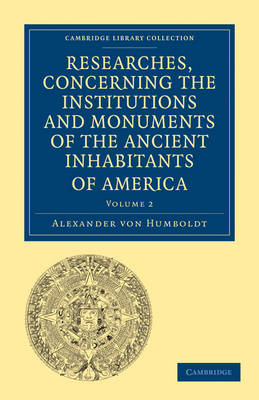
Researches, Concerning the Institutions and Monuments of the Ancient Inhabitants of America, with Descriptions and Views of Some of the Most Striking Scenes in the Cordilleras!
Cambridge University Press (Verlag)
978-1-108-02791-5 (ISBN)
Alexander von Humboldt (1769–1859) was an internationally respected scientist and explorer whose meticulous approach to scientific observation greatly influenced later research. He travelled the world, once staying at the White House as a guest of Thomas Jefferson, and is commemorated in the many species and places which bear his name. This two volume work, published in French in 1810 as Vue des Cordillères, and in this English translation in 1814, was one of the many publications that resulted from Humboldt's expedition to Latin America in 1799–1804. It describes geographical features such as volcanoes and waterfalls, and aspects of the indigenous cultures including architecture, sculpture, art, languages and writing systems, religions, costumes and artefacts. This approachable, closely observed travelogue vividly recounts a huge variety of impressions and experiences, and reveals Humboldt's boundless curiosity as well as his scientific and cultural knowledge.
25. House of the Inca at Callo; 26. Chimborazo seen from the Plain of Tapia; 27. Epochas of nature, according to the Azteck mythology; 28. Hieroglyphic painting, taken from the Borgian manuscript of Veletri, and signs of the days of the Mexican almanac; 29. An Azteck hatchet; 30. An Azteck idol of basaltic porphyry, found under the pavement of the great square at Mexico; 31. Cataract of the Rio Vinagre, near the volcano of Purace; 32. Postman of the province of Jaen de Bracamoros; 33. Hieroglyphical history of the Aztecks, from the Deluge to the foundation of the city of Mexico; 34. Bridge of Ropes near Penipé; 35. Coffer of Perote; 36. Mountain of Ilinissa; 37. Fragments of Azteck hieroglyphics, deposited in the Royal Library of Berlin; 38. Hieroglyphic paintings in the Borgian Museum, at Veletri; 39. Migration of the Azteck nation, from a hieroglyphic painting deposited in the Royal Library at Berlin; 40. Vases of granite found on the coast of Honduras; 41. An Azteck idol, in basalt, found in the valley of Mexico; 42. Air volcano of Turbaco; 43. Volcano of Cayambe; 44. Volcano of Jorullo; 45. Calendar of the Muysca Indians, the ancient inhabitants of the Plain of Bogota; 46. Fragment of a hieroglyphical manuscript preserved in the Royal Library; 47. Hieroglyphic paintings taken from the Mexican manuscript, preserved in the Imperial Library at Vienna, Nos. 1, 2, and 3; Ruins of Miguitlan, or Mitla, in the province of Oaxaca; 48. View of Corazon; 49. Costumes of the Indians of Mechoacan; 50. View of the interior of the crater of the Peak of Teneriffe; 51. Fragments of hieroglyphic paintings, taken from the Codex Telleriano-Remensis; 52. Fragment of a Christian calendar, taken from the Azteck manuscripts, preserved in the Royal Library of Berlin; 53. Hieroglyphic paintings from the Raccolta di Mendoza; 54. Fragments of Azteck paintings, taken from a manuscript preserved in the library of the Vatican; 55. Volcano of Pichincha; 56. Plan of a fortified house of the Inca, situated on the Cordillera of Assuay, ruins of a part of the ancient Peruvian city of Chulucanas; 57. Raft of the river of Guayaquil; 58. Summit of the mountain of Organos, at Actopan; 59. Mountains of columnar porhyry of Jacal; 60. A head sculptured in hard stone by the Muysca Indians. Bracelet of obsidian; 61. View of the lake of Guatavita; 62. View of the Silla de Caracas; 63. The dragon-tree of Orotava; 64. Letter from Mr Visconti, member of the National Institute of France, to M. de Humboldt, on certain monuments of the American nations; Notes; Indexes.
| Erscheint lt. Verlag | 2.6.2011 |
|---|---|
| Reihe/Serie | Researches, Concerning the Institutions and Monuments of the Ancient Inhabitants of America with Descriptions and Views of Some of the Most Striking Scenes in the Cordilleras! 2 Volume Paperback Set ; Volume 2 |
| Übersetzer | Helen Maria Williams |
| Zusatzinfo | 3 Plates, unspecified; 8 Plates, black and white |
| Verlagsort | Cambridge |
| Sprache | englisch |
| Maße | 20 x 216 mm |
| Gewicht | 440 g |
| Themenwelt | Reisen ► Reiseberichte ► Nord- / Mittelamerika |
| Geschichte ► Allgemeine Geschichte ► Neuzeit (bis 1918) | |
| Geisteswissenschaften ► Geschichte ► Regional- / Ländergeschichte | |
| ISBN-10 | 1-108-02791-1 / 1108027911 |
| ISBN-13 | 978-1-108-02791-5 / 9781108027915 |
| Zustand | Neuware |
| Haben Sie eine Frage zum Produkt? |
aus dem Bereich


